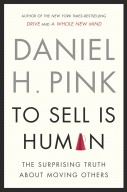Always Ask–And Answer–These Two Questions

[Full disclosure: I applied, and was selected, to be on the unpaid launch team for the book, To Sell is Human. I am one of 96 team members across the globe who got advance copies of the book, as well as the "first mover package" that comes with pre-ordering the book. My review below is based solely on the merits of the book. In other words, I would have written the same review, independent of being on the launch team.]
One of my favorite authors, Dan Pink, has a new book, To Sell Is Human, coming out on Dec 31. Even if you don't think of yourself as selling, the book argues successfully that we are all in sales. Unless you are in a coma, our daily life and work requires each of us to influence others in some way–whether it's getting your child to finish their homework, or getting funding for a project at work, or motivating an employee to stay late for the umpteenth time. The author calls this "non-sales selling". We aren't selling a tangible product or service, but we are selling, nonetheless.
So, we're all in sales. So what?
If you're like me, traditional sales techniques feel manipulative. It feels like only flaming extroverts could pull them off. (Some of my best friends are extroverts in sales, so nothing against them.)
Fortunately, Pink makes the case for why the schmoozy model of sales is dead, largely due to the buyer's accessibility to information via the Internet. When I can research everything about a car, including profit margins, reliability, and maintenance history, even before stepping into a showroom, I'm no longer at a disadvantage. Instead of "buyer beware", it's now "seller beware". Not only do I have equal information for the transaction, but I can easily publicize to my friends on social media if you, the seller, is a jerk.
The author draws on research from social psychology to give the reader a roadmap for how to influence others in this new landscape. What he comes up with is fresh, easy to implement with a little effort, and sometimes so simple that it's startling. The book outlines six ideas that speak to the being and doing of selling: Attunement, Buoyancy, Clarity, Pitch, Improvise, and Serve. Watch the following video for more:
While it may take work to integrate these concepts into how you operate (you'll largely be undoing many of the stereotypes about selling that have been drilled into your head for decades), you'll find "selling" to be more fun and natural. More importantly, Pink has created a framework for fulfilling a desire that most people who walk this planet have–to serve others with integrity.
After reading all five of his books and interviewing him multiple times, I realize that what makes Dan Pink's work so compelling is that he is first and foremost, a humanist. Yes, he's big on research and factoids. But underlying all of that is being of service and making the world a better place. Photo by douas
Which leads me to the title of this post. Most likely you've heard that the best salespeople have an attitude of service. But what does that really mean? Pink gives a yardstick to measure ourselves by–two questions to ask and answer when you are attempting to influence someone:
- If the person you're selling agrees to buy, will his or her life improve?
- When your interaction is over, will the world be a better place than when you began?
He goes on to say: "If the answer to either of these questions is no, you're doing something wrong."
If you've never read any of Pink's books, start now with this one. His writing is a mixture of:
- Insights backed by hard research (e.g., charts by the U.S. Bureau of Labor Statistics and studies from well-regarded academics.)
- First person stories that come out of his personal research (e.g., shadowing the last Fuller Brush man in America, taking an improv class with a cosmetic company executive and other professionals wanting to get better at their jobs.)
- Tools, exercises and resources to help you put the insights into action (e.g., a three-step process for being a better curator of information for your audience, templates for six new kinds of pitches, designating a "slow day" when you'll wait five seconds before opening your mouth in a conversation.)
BTW–when you pre-order the book before Dec 30, you'll get his "First Mover Package"–a veritable Santa's bag full of goodies (e.g., access to a live call with Pink on New Year's Day, a workbook, two recorded interviews with social psychology researchers and thought leaders.) Gift yourself the book. Really. Do it.
I’ve read the book and am biased toward Dan. I tried however, to put that aside and look at your post her objectively. No way around it. You totally nailed it. And you did so with Peter Drucker-ish clarity. Simply extraordinary!
Thanks, Dave, for your kind words! I do my best writing when inspiration hits. I read a lot of books. It occurred to me yesterday the unique mix that makes Dan Pink’s writing distinctive and appealing. I thoroughly enjoyed the book and am trying to put the concepts into practice.